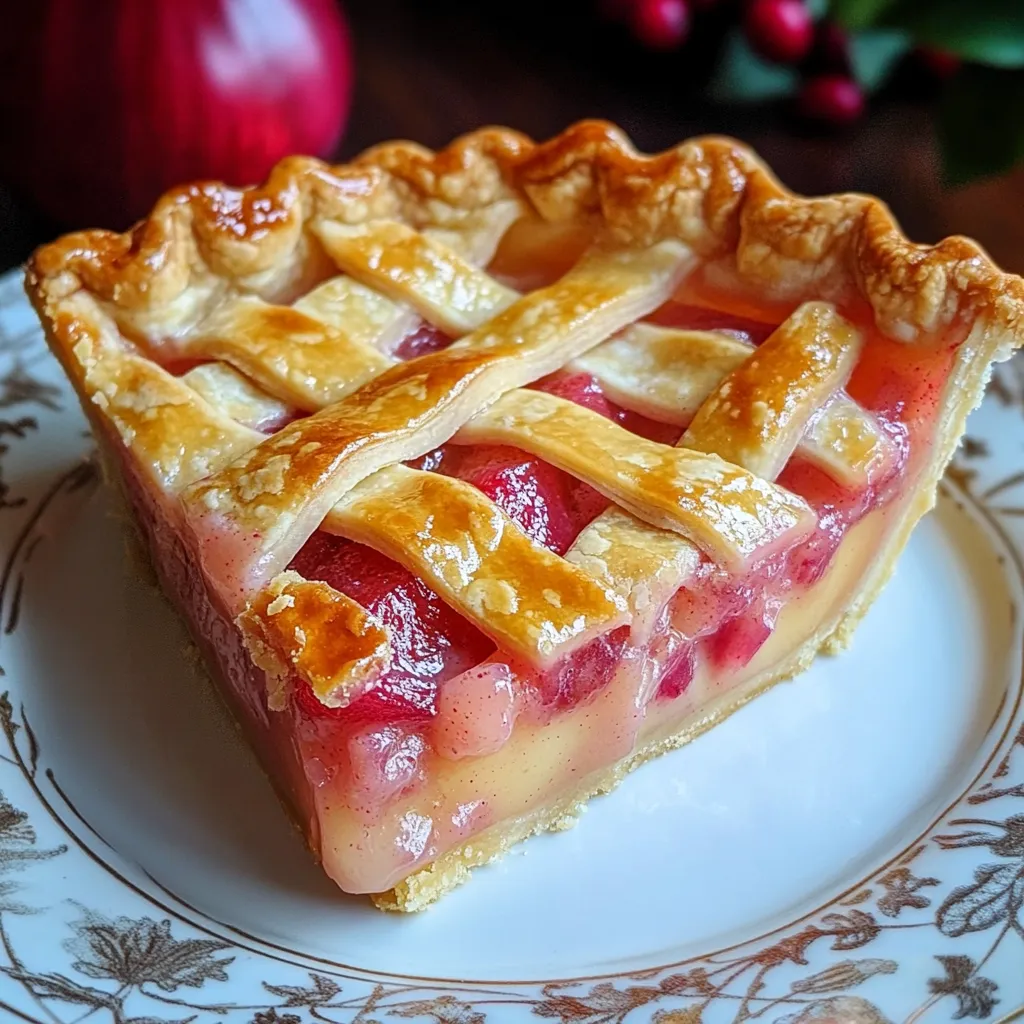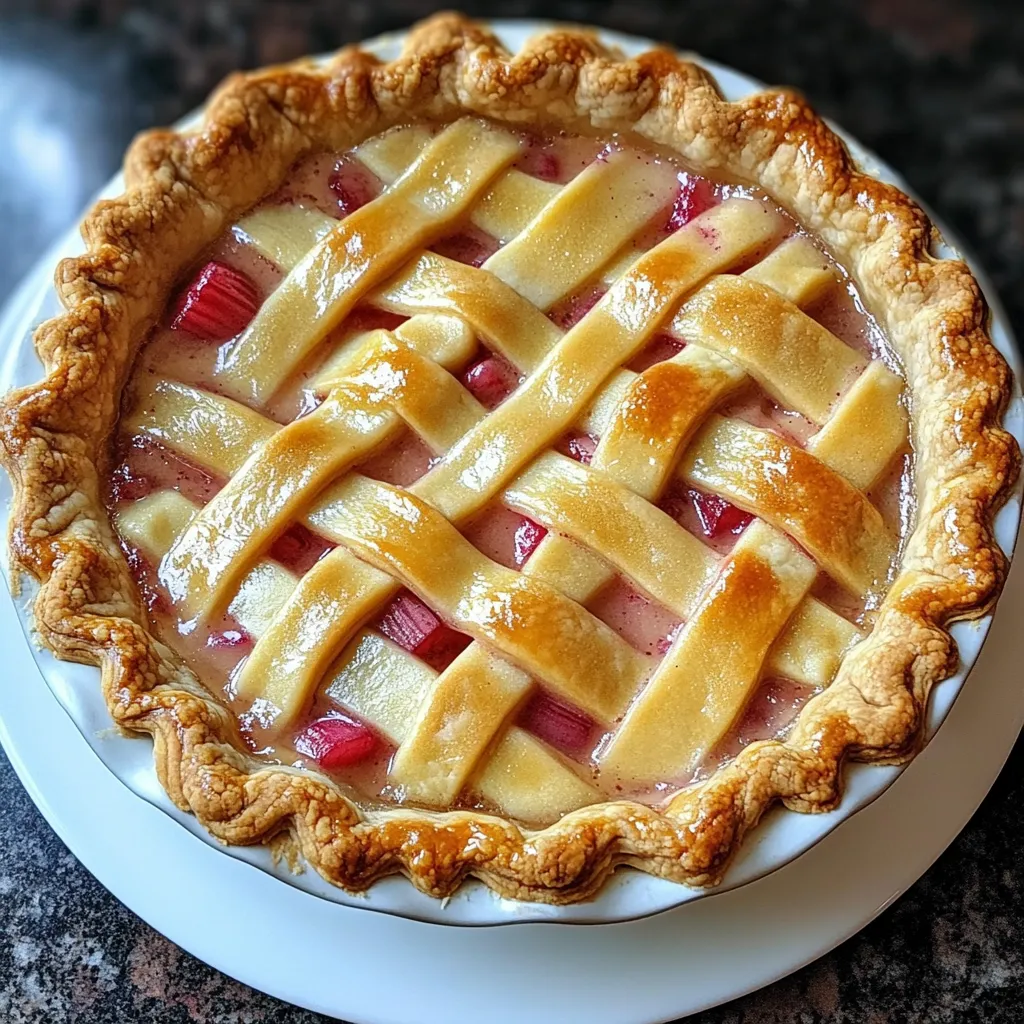 Pin it
Pin it
This time-tested rhubarb custard pie combines the perfect balance of tart, fresh rhubarb with a luscious creamy custard, all encased in a buttery, flaky crust that melts in your mouth. The lattice top not only adds visual appeal but allows just the right amount of moisture to escape while baking.
I first made this pie for my grandmother's birthday after finding her handwritten recipe card. The moment that first slice hit the plate, the familiar aroma transported everyone at the table back to childhood Sunday dinners in her kitchen.
Ingredients
- All-purpose flour: Forms the foundation of our flaky crust while also helping thicken the custard filling to the perfect consistency
- Cold unsalted butter: Cut into small cubes creates those essential flaky layers in the crust
- Fresh rhubarb stalks: Provide the signature tartness this pie is known for; choose firm, bright stalks without blemishes
- Granulated sugar: Balances the natural tartness of the rhubarb without overpowering it
- Large eggs: Give the custard its rich texture and help it set properly during baking
- Heavy cream: Creates that luxurious mouthfeel that makes this custard exceptional
- Vanilla extract: Adds warmth and depth to the filling, enhancing the natural flavors
- Ground nutmeg: Brings a subtle warmth that complements the rhubarb beautifully
 Pin it
Pin it
Step-by-Step Instructions
- Prepare the crust:
- Combine flour and salt in a large bowl, then work in cold butter cubes using a pastry blender until you achieve a mixture with pieces ranging from pea-size to coarse crumbs. The varying sizes create different layers of flakiness. Gradually add ice-cold water just until the dough comes together without becoming sticky. Divide in half, flatten into discs, wrap, and chill for at least 30 minutes to relax the gluten.
- Roll the bottom crust:
- On a lightly floured surface, roll one disc into a 12-inch circle using gentle, even pressure from the center outward, rotating the dough quarter-turns to maintain an even circle. Transfer to your pie plate by draping it over your rolling pin, then gently easing it into the corners without stretching the dough, which would cause shrinkage during baking.
- Create the custard filling:
- Toss chopped rhubarb with sugar, flour, and salt in a large bowl, ensuring each piece gets coated. This sugar coating helps draw out some moisture while the flour helps thicken the juices. In a separate bowl, whisk together the eggs, heavy cream, vanilla, and nutmeg until completely blended, then pour over the rhubarb mixture, folding gently to avoid breaking the rhubarb pieces.
- Assemble and top the pie:
- Pour the prepared filling into your bottom crust, smoothing it into an even layer. Roll the second disc of dough and cut into even strips for your lattice. Create the lattice by laying half the strips parallel across the pie, then weaving the remaining strips perpendicular through them, alternating over and under. Trim edges and crimp decoratively to seal.
- Bake with precision:
- Start at a higher temperature, 400°F for 15 minutes, to set the structure of the crust, then reduce to 350°F for the remaining time. This temperature shift prevents a soggy bottom while allowing the custard to gently set without curdling. Watch for golden brown edges and slight jiggle in the center, which indicates proper doneness.
- Cool completely:
- Allow the pie to cool fully on a wire rack for at least 4 hours before slicing. This patience is rewarded with properly set custard that holds its shape when sliced rather than running all over the plate.
Nutmeg is my secret weapon in this recipe. My grandmother always kept a whole nutmeg and a tiny grater in her spice drawer exclusively for this pie. The first time I grated fresh nutmeg over the filling mixture, the intensely aromatic scent brought tears to my eyes as it triggered memories of standing beside her at the counter helping as a child.
Rhubarb Selection Matters
When selecting rhubarb for your pie, look for stalks that are firm, crisp, and have a bright color ranging from pale pink to deep red. Avoid any stalks that appear limp, wilted, or have brown spots. Contrary to popular belief, the color doesn't necessarily indicate sweetness, but younger, thinner stalks tend to be more tender and require less sugar. If using frozen rhubarb, thaw completely and drain off excess liquid before using; otherwise, your custard may become too watery.
Make-Ahead Options
This pie works beautifully as a make-ahead dessert. You can prepare the dough up to three days in advance, keeping it tightly wrapped in the refrigerator. The entire assembled unbaked pie can be frozen for up to one month; simply wrap well in plastic followed by foil. When ready to bake, do not thaw first; just add about 15 minutes to the baking time. A fully baked, cooled pie will keep at room temperature for two days or refrigerated for up to five days, making it perfect for busy holiday preparations.
 Pin it
Pin it
Seasonal Adaptations
While traditional rhubarb custard pie celebrates spring's first harvest, you can adapt this recipe throughout the year. In summer, add a cup of sliced strawberries to create the classic strawberry-rhubarb combination, reducing the sugar slightly to account for the berries' sweetness. In fall, try adding diced apple and a teaspoon of cinnamon. During winter months, when fresh rhubarb is unavailable, frozen works beautifully; just be sure to fully thaw and drain before using to prevent excess moisture in your filling.
Frequently Asked Questions
- → How do I ensure the crust stays flaky?
Ensure the butter stays cold during the dough-making process. Avoid overworking the dough, and chill it before rolling out.
- → Can I use frozen rhubarb for this pie?
Yes, frozen rhubarb works well. Be sure to thaw it completely and drain excess liquid to avoid a soggy filling.
- → What’s the key to a perfect custard filling?
Whisk the eggs, cream, and vanilla thoroughly, and gently fold them into the rhubarb to maintain the correct consistency.
- → How can I prevent the pie edges from burning?
Cover the edges with foil or a pie shield once they become golden during baking. This ensures even baking without overbrowning.
- → How long should I let the pie cool before slicing?
Allow the pie to cool completely on a wire rack for at least 2-3 hours. This helps the custard set properly for clean slices.
- → Can I substitute sugar with another sweetener?
Yes, you can use alternatives like honey or a sugar substitute, but adjust the quantities to suit the sweetness level and ensure the filling consistency remains the same.
